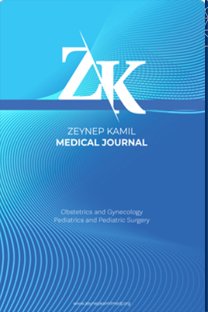Assessment of perinatal outcomes of pregnancies conceived by in vitro fertilization-intracytoplasmic sperm injection
Assessment of perinatal outcomes of pregnancies conceived by in vitro fertilization-intracytoplasmic sperm injection
___
- 1. Zhu JL, Obel C, Hammer Bech B, Olsen J, Basso O. Infertility, infertility treatment, and fetal growth restriction. Obstet Gynecol 2007;110(6):1326–34.
- 2. Hayashi M, Nakai A, Satoh S, Matsuda Y. Adverse obstetric and perinatal outcomes of singleton pregnancies may be related to maternal factors associated with infertility rather than the type of assisted reproductive technology procedure used. Fertil Steril 2012;98(4):922–8.
- 3. Mayer A, Lunenfeld E, Wiznitzer A, Har-Vardi I, Bentov Y, Levitas E. Increased prevalence of gestational diabetes mellitus in in vitro fertilization pregnancies inadvertently conceived during treatment with long-acting triptorelin acetate. Fertil Steril 2005;84(3):789–92.
- 4. Schenker JG, Ezra Y. Complications of assisted reproductive techniques. Fertil Steril 1994;61(3):411–22.
- 5. Zádori J, Kozinszky Z, Orvos H, Katona M, Pál A, Kovács L. Dilemma of increased obstetric risk in pregnancies following IVF-ET. J Assist Reprod Genet 2003;20(6):216–21.
- 6. Pandey S, Shetty A, Hamilton M, Bhattacharya S, Maheshwari A. Obstetric and perinatal outcomes in singleton pregnancies resulting from IVF/ICSI: A systematic review and meta-analysis. Hum Reprod Update 2012;18(5):485–503.
- 7. Pinborg A, Wennerholm UB, Romundstad LB, Loft A, Aittomaki K, Söderström-Anttila V, et al. Why do singletons conceived after assisted reproduction technology have adverse perinatal outcome? Systematic review and meta-analysis. Hum Reprod Update 2013;19(2):87–104.
- 8. Helmerhorst FM, Perquin DA, Donker D, Keirse MJ. Perinatal outcome of singletons and twins after assisted conception: A systematic review of controlled studies. BMJ 2004;328(7434):261.
- 9. Schieve LA, Meikle SF, Ferre C, Peterson HB, Jeng G, Wilcox LS. Low and very low birth weight in infants conceived with use of assisted reproductive technology. N Engl J Med 2002;346:731–7.
- 10. Lalosević D, Tabs D, Krnojelac D, Vejnović T, Radunović N. Histological characteristics of placentas from assisted reproduction programs. Med Pregl 2003;56(11–12):521–7.
- 11. Zhang Y, Zhao W, Jiang Y, Zhang R, Wang J, Li C, et al. Ultrastructural study on human placentae from women subjected to assisted reproductive technology treatments. Biol Reprod 2011;85(3):635–42.
- 12. Carbone IF, Cruz JJ, Sarquis R, Akolekar R, Nicolaides KH. Assisted conception and placental perfusion assessed by uterine artery Doppler at 11-13 weeks’ gestation. Hum Reprod 2011;26(7):1659–64.
- 13. Mercader A, Garcia-Velasco JA, Escudero E, Remohí J, Pellicer A, Simón C. Clinical experience and perinatal outcome of blastocyst transfer after coculture of human embryos with human endometrial epithelial cells: A 5-year follow-up study. Fertil Steril 2003;80(5):1162–8.
- 14. Desai N, Lawson J, Goldfarb J. Assessment of growth factor effects on post-thaw development of cryopreserved mouse morulae to the blastocyst stage. Hum Reprod 2000;15(2):410–8.
- 15. Prefumo F, Fratelli N, Soares SC, Thilaganathan B. Uterine artery Doppler velocimetry at 11-14 weeks in singleton pregnancies conceived by assisted reproductive technology. Ultrasound Obstet Gynecol 2007;29(2):141–5.
- 16. Toshimitsu M, Nagamatsu T, Nagasaka T, Iwasawa-Kawai Y, Komatsu A, Yamashita T, et al. Increased risk of pregnancy-induced hypertension and operative delivery after conception induced by in vitro fertilization/intracytoplasmic sperm injection in women aged 40 years and older. Fertil Steril 2014;102(4):1065–70.e1.
- 17. Woldringh GH, Frunt MH, Kremer JA, Spaanderman ME. Decreased ovarian reserve relates to pre-eclampsia in IVF/ICSI pregnancies. Hum Reprod 2006;21(11):2948–54.
- 18. Marchand E, Poncelet C, Carbillon L, Pharisien I, Tigaizin A, Chanelles O. Les grossesses issues de l’assistance médicale à la procréation se compliquent-elles plus que les grossesses spontanées? Étude rétrospective sur six ans [Is there more complications with pregnancies from the assisted reproductive technology than spontaneous pregnancies? A retrospective study over 6 years]. J Gynecol Obstet Biol Reprod (Paris) 2011;40(6):522–8.
- 19. Grady R, Alavi N, Vale R, Khandwala M, McDonald SD. Elective single embryo transfer and perinatal outcomes: A systematic review and meta-analysis. Fertil Steril 2012;97(2):324–31.
- 20. Jackson RA, Gibson KA, Wu YW, Croughan MS. Perinatal outcomes in singletons following in vitro fertilization: A meta-analysis. Obstet Gynecol 2004;103(3):551–63.
- 21. Ashrafi M, Gosili R, Hosseini R, Arabipoor A, Ahmadi J, Chehrazi M. Risk of gestational diabetes mellitus in patients undergoing assisted reproductive techniques. Eur J Obstet Gynecol Reprod Biol 2014;176:149– 52.
- ISSN: 1300-7971
- Yayın Aralığı: 4
- Yayıncı: Ali Cangül
Ectopic pelvic kidney: Prenatal diagnosis and management
Gürcan TÜRKYILMAZ, Bilal ÇETİN
An overview of anaphylaxis in children
Seroprevalence of Varicella-Zoster in the first trimester of pregnancy
Effects of topical Povidone-iodine on thyroid function in surgical newborns
Ayşenur CELAYİR, Sırma Mine TİLEV, Burcu ARI, Tuba ERDEM
Anxiety, quality of life, eating behaviors, and sexual life in women with polycystic ovary syndrome
Gülfem BAŞOL, Sevil KİREMİTLİ, Tunay KİREMİTLİ, Paşa ULUĞ, Kemine UZEL
Fırat TÜLEK, Bülent Berker, Alper KAHRAMAN
Funda GÜNGÖR UĞURLUCAN, Cenk YAŞA, Sina ARMAN, Ekin İlke ŞEN, Nalan ÇAPAN, Gülşah GULA, Ayşe KARAN
Evaluation of blood pressures measured at the clinic and during exercise test in children
Nurdan EROL, Çiğdem EROL, İlke AKTAŞ
External anal sphincter repair by the overlapping method in obstetric anal sphincter injury syndrome
